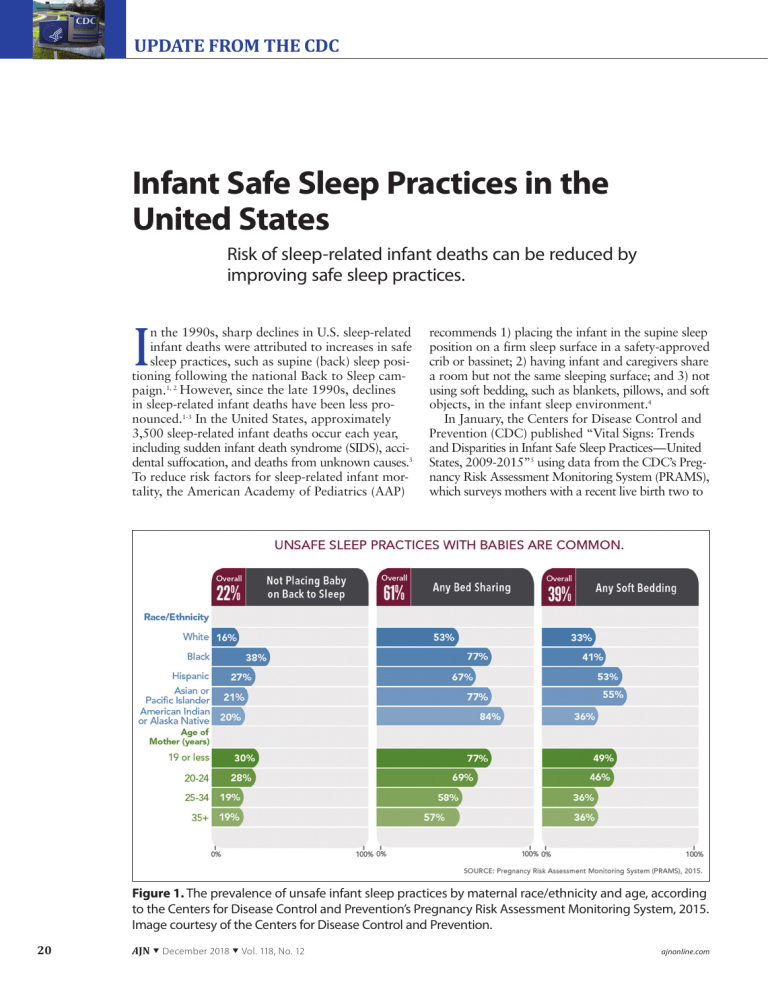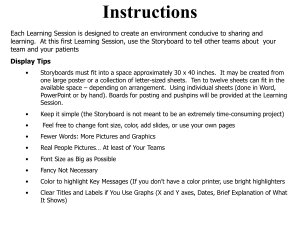
UPDATE FROM THE CDC Infant Safe Sleep Practices in the United States Risk of sleep-related infant deaths can be reduced by improving safe sleep practices. I n the 1990s, sharp declines in U.S. sleep-related infant deaths were attributed to increases in safe sleep practices, such as supine (back) sleep positioning following the national Back to Sleep campaign.1, 2 However, since the late 1990s, declines in sleep-related infant deaths have been less pronounced.1-3 In the United States, approximately 3,500 sleep-related infant deaths occur each year, including sudden infant death syndrome (SIDS), accidental suffocation, and deaths from unknown causes.3 To reduce risk factors for sleep-related infant mortality, the American Academy of Pediatrics (AAP) recommends 1) placing the infant in the supine sleep position on a firm sleep surface in a safety-approved crib or bassinet; 2) having infant and caregivers share a room but not the same sleeping surface; and 3) not using soft bedding, such as blankets, pillows, and soft objects, in the infant sleep environment.4 In January, the Centers for Disease Control and Prevention (CDC) published “Vital Signs: Trends and Disparities in Infant Safe Sleep Practices—United States, 2009-2015”5 using data from the CDC’s Pregnancy Risk Assessment Monitoring System (PRAMS), which surveys mothers with a recent live birth two to Figure 1. The prevalence of unsafe infant sleep practices by maternal race/ethnicity and age, according to the Centers for Disease Control and Prevention’s Pregnancy Risk Assessment Monitoring System, 2015. Image courtesy of the Centers for Disease Control and Prevention. 20 AJN ▼ December 2018 ▼ Vol. 118, No. 12 ajnonline.com By Jennifer M. Bombard, MSPH, Katherine Kortsmit, PhD, Carri Cottengim, MA, and Emily O. Johnston, MPH six months after delivery. The CDC report showed that unsafe infant sleep practices were common in 2015: about one in five (22%) mothers reported not placing her infant on her or his back to sleep, more than half of mothers (61%) reported bed sharing with their infant, and nearly two in five (39%) mothers reported using soft bedding in their infant’s sleep environment (see Figure 1).5 Unsafe sleep practices were most commonly reported by younger, less educated, and racial/ethnic minority mothers. Despite safe sleep recommendations, unsafe sleep practices are still common. Nurses and other health care providers have a unique opportunity to educate parents and other infant caregivers on safe sleep practices during clinical encounters such as prenatal care visits, postdelivery hospital visits, postdischarge home visits, and infant health care visits. Health care providers positively influence safe sleep practices by providing correct advice and modeling safe sleep practices.6-8 To assist nurses and other health care providers in educating caregivers and modeling safe sleep practices, the National Institutes of Health (NIH) offers continuing education credits for completing its online training, Risk Reduction for SIDS and Other Sleep-Related Causes of Infant Death, available at www1.nichd.nih.gov/ cbt/sids/nursececourse/Welcome.aspx. Additional provider and caregiver educational resources from the NIH Safe to Sleep campaign are available at www1.nichd.nih.gov/sts/materials/Pages/default.aspx, and educational materials, including a fact sheet, are available on the CDC’s Vital Signs website (www.cdc. gov/vitalsigns/safesleep/index.html). Finally, some states have developed hospital-based interventions to improve safe sleep practices.7, 8 Continued surveillance of U.S. infant sleep practices is necessary to monitor whether the prevalence of safe sleep practices changes over time, especially among populations where sleep-related infant mortality is disproportionately high.1, 2 The state-specific estimates derived from PRAMS can complement other data sources used to assess initiatives to reduce sleeprelated deaths. The CDC currently supports surveillance in states and jurisdictions through its Sudden Unexpected Infant Death (SUID) Case Registry.9 Key objectives of the registry are to improve the quality and completeness of SUID investigations; improve the quality, timeliness, and completeness of the data ajn@wolterskluwer.com compiled; and use data findings to inform strategies, including policy and practice changes. Findings have been shared by registry participants with hospitals in their state or jurisdiction. As a result, hospitals have implemented activities to promote the AAP safe sleep recommendations, including policy changes and patient education.9 Despite safe sleep recommendations to reduce the risk of sleep-related infant deaths, unsafe sleep practices are still common. Health care providers, including nurses, can play an important role in promoting implementation of the AAP safe sleep recommendations. Health care providers can counsel caregivers on safe sleep practices; ask caregivers how they place babies to sleep; identify challenges to following the AAP recommendations; and help caregivers find solutions, including introducing them to services, such as free or reduced-cost cribs. In addition to following the latest recommendations from the AAP for safe sleep, providers can also model safe sleep practices for caregivers in the hospital and in other health care settings. ▼ Jennifer M. Bombard is an epidemiologist in the Division of Reproductive Health, National Center for Chronic Disease and Health Promotion, Centers for Disease Control and Prevention, Atlanta, where Katherine Kortsmit is an Oak Ridge Institute for Science and Education fellow, Carri Cottengim is a health scientist, and Emily O. Johnston is a public health advisor. Contact author: Jennifer M. Bombard, jbombard@cdc.gov. The authors have disclosed no potential conflicts of interest, financial or otherwise. The findings and conclusions in this report are those of the authors and do not necessarily represent the official position of the Centers for Disease Control and Prevention. REFERENCES 1. Erck Lambert AB, et al. National and state trends in sudden unexpected infant death: 1990-2015. Pediatrics 2018;141(3): e20173519. 2. Parks SE, et al. Racial and ethnic trends in sudden unexpected infant deaths: United States, 1995-2013. Pediatrics 2017;139(6):e20163844. 3. Mathews TJ, et al. Infant mortality statistics from the 2013 period linked birth/infant death data set. Natl Vital Stat Rep 2015;64(9):1-30. 4. Moon RY; Task Force on Sudden Infant Death Syndrome. SIDS and other sleep-related infant deaths: evidence base for 2016 updated recommendations for a safe infant sleeping environment. Pediatrics 2016;138(5):e20162940. 5. Bombard JM, et al. Vital signs: trends and disparities in infant safe sleep practices—United States, 2009-2015. MMWR Morb Mortal Wkly Rep 2018;67(1):39-46. 6. Colson ER, et al. Factors associated with choice of infant sleep position. Pediatrics 2017;140(3):e20170596. 7. Heitmann R, et al. Improving safe sleep modeling in the hospital through policy implementation. Matern Child Health J 2017;21(11):1995-2000. 8. Hwang SS, et al. Implementation of safe sleep practices in the neonatal intensive care unit. J Perinatol 2015;35(10):862-6. 9. Centers for Disease Control and Prevention, Division of Reproductive Health. Sudden unexpected infant death and sudden infant death syndrome: SUID and SDY case registries. 2018. https://www.cdc.gov/sids/CaseRegistry.htm. AJN ▼ December 2018 ▼ Vol. 118, No. 12 21


